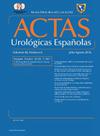HCY、c-sdLDL、肌酐、IL-6和PSA在老年人良性前列腺增生诊断中的值
IF 1.2
4区 医学
Q3 UROLOGY & NEPHROLOGY
引用次数: 0
摘要
目的探讨血清代谢指标HCY、sdLDL-C、Crea、炎性因子IL-6、前列腺特异性抗原对老年前列腺增生(BPH)的诊断价值。方法选择老年前列腺增生患者150例作为观察组,健康老年患者169例作为对照组。收集两组患者的tPSA、fPSA、fPSA/tPSA及前列腺大小数据,采集受试者血清样本检测HCY、sdLDL、Crea、IL-6等指标。采用单因素分析、相关分析和logistic回归分析分析各指标与老年性前列腺增生的关系。采用受试者工作特征曲线(ROC)分析各血清代谢物的诊断效能。结果患者血清tPSA、fPSA、Crea、HCY、sdLDL-C、IL-6水平均显著升高,fPSA/tPSA比值、HDL显著降低,TCHO、TG、LDL水平差异均无统计学意义。血清tPSA、fPSA水平与前列腺大小呈正相关,血清IL-6、Crea、HCY水平与tPSA、fPSA水平呈正相关,血清sdLDL-C水平与fPSA水平呈负相关。Logistic回归分析显示tPSA、fPSA、前列腺大小、HCY、Crea、IL-6是前列腺增生的危险因素。HDL和fPSA/tPSA是良性前列腺增生的保护因子。ROC曲线分析显示,fPSA/tPSA和IL-6的敏感性和特异性分别为82.7%和72%,83.4%和80.5%,ROC曲线下面积分别为0.840和0.825。tPSA和fPSA联合HCY、IL-6和Crea的诊断效果最好,ROC曲线下面积为0.881,特异性和敏感性分别为84%和77.3%。结论前列腺特异性抗原、HCY、Crea、IL-6联合检测可显著提高老年性前列腺增生的诊断效率,优化诊断和治疗方案,甚至可作为评价和预测老年性前列腺增生中BPH发生的主要筛查指标。本文章由计算机程序翻译,如有差异,请以英文原文为准。

Valor de HCY, c-sdLDL, creatinina, IL-6 y PSA en el diagnóstico de la hiperplasia prostática benigna en el anciano
Objective
To investigate the diagnostic value of serum metabolic markers such as HCY, sdLDL-C, Crea, inflammatory factor IL-6 and prostate-specific antigen in elderly patients with prostatic hyperplasia (BPH).
Methods
150 senile patients with hyperplasia of prostate were selected as observation group and 169 healthy senile patients were selected as control group. The tPSA, fPSA, fPSA/tPSA and prostate size data of the two groups were collected, and serum samples of the subjects were collected for the detection of HCY, sdLDL, Crea, IL-6 and other indicators. Univariate analysis, correlation analysis and logistic regression analysis were conducted to analyze the relationship between each index and senility prostatic hyperplasia. The diagnostic efficiency of each serum metabolite was analyzed by receiver operating characteristic curve (ROC).
Results
Serum levels of tPSA, fPSA, Crea, HCY, sdLDL-C and IL-6 were significantly increased, fPSA/tPSA ratio and HDL were significantly decreased, and TCHO, TG and LDL had no statistical significance. Serum tPSA and fPSA levels were positively correlated with prostate size, serum IL-6, Crea and HCY levels were positively correlated with tPSA and fPSA levels, and serum sdLDL-C levels were negatively correlated with fPSA levels. Logistic regression analysis showed that tPSA, fPSA, prostate size, HCY, Crea and IL-6 were risk factors for prostate hyperplasia. HDL and fPSA/tPSA are protective factors for benign prostatic hyperplasia. ROC curve analysis showed that the sensitivity and specificity of fPSA/tPSA and IL-6 were 82.7% and 72%, 83.4% and 80.5%, and the area under ROC curve were 0.840 and 0.825, respectively. tPSA and fPSA combined with HCY, IL-6 and Crea had the best diagnostic efficiency, with the area under ROC curve reaching 0.881, specificity and sensitivity reaching 84% and 77.3%, respectively.
Conclusion
The combined detection of prostate-specific antigen, HCY, Crea and IL-6 can significantly improve the diagnostic efficiency of senile prostatic hyperplasia, and optimize the diagnosis and treatment scheme can even be used as a major screening index to evaluate and predict the incidence of BPH in senile prostatic hyperplasia.
求助全文
通过发布文献求助,成功后即可免费获取论文全文。
去求助
来源期刊

Actas urologicas espanolas
UROLOGY & NEPHROLOGY-
CiteScore
1.90
自引率
0.00%
发文量
98
审稿时长
46 days
期刊介绍:
Actas Urológicas Españolas is an international journal dedicated to urological diseases and renal transplant. It has been the official publication of the Spanish Urology Association since 1974 and of the American Urology Confederation since 2008. Its articles cover all aspects related to urology.
Actas Urológicas Españolas, governed by the peer review system (double blinded), is published online in Spanish and English. Consequently, manuscripts may be sent in Spanish or English and bidirectional free cost translation will be provided.
 求助内容:
求助内容: 应助结果提醒方式:
应助结果提醒方式:


